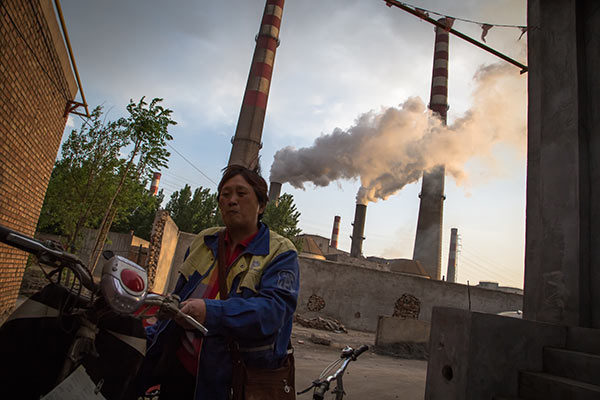Inspectors detail past Hebei laxity
Updated: 2016-05-04 08:02
By Zheng Jinran(China Daily)
|
|||||||||
|
A resident reacts to the air in Handan, Hebei province, in April. The city, known for its highly polluting industries, such as steel, is facing an industrial transformation.Provided To China Daily |
Team cites loose supervision, failure of former leaders to prioritize reductions of pollution
The national environmental protection inspection team said on Tuesday that former top leaders in Hebei province, through a pattern of loose supervision, had neglected their duty to curb pollution.
Efforts by the provincial government have a long way to go in meeting the expectations of the central government and the public, inspectors said in a report released on Tuesday.
Among a series of problems exposed, the leaders failed to take environmental protection work seriously, despite requirements laid down by the central government from 2013 and reiterated many times over two years. For example, Hebei failed to provide sufficient funds for projects curbing air pollution. The provincial funds allocated for curbing air pollution accounted for only 15.5 percent of money provided by the central government from 2013 to 2015, the report said.
Inspectors said they also found many illegal projects that had been approved, even though they violated national and provincial restrictions to cut emissions in some industries, such as iron and steel.
It was the first release of findings by the team after the inspection began in January. Inspectors are to examine the environmental performance of officials nationwide over the next two years.
In the feedback to Hebei, the team spoke of problems that have drawn public attention beginning in 2013 and ending in July.
"It exposed the problems existing in the former provincial leadership," said Chang Jiwen, deputy director of the Institute for Resources and Environment Policies, under the Development Research Center of the State Council.
Hebei may not be not alone, as problems may exist in many provinces, so direct exposure serves as a warning from the central government, reminding other provinces to pay sufficient attention to curbing pollution, he said.
The team spoke highly of the province's performance under new leadership headed by Party chief Zhao Kezhi, saying environmental quality has seen clear improvement and many policies to reduce pollution have now been put in place.
Four major problems discovered during the inspections in Hebei
Local governments and departments did not pay sufficient attention to curbing pollution. For example, the province's Development and Reform Commission and other related authorities did not strictly monitor oil production quality and did not reduce the number of outdated iron and steel projects.
Many projects were approved and launched despite laws and regulations that made them illegal. For example, 151 villas were built in protected zones after 2012 along the Hutuo River and the Gangnan Reservoir, major water sources for Shijiazhuang, the provincial capital. In addition, Tangshan city approved and launched four projects that produced iron alloy, despite the province already having excess capacity.
Many initiatives aimed at reducing the number of iron - and steel-producing projects and cutting the use of low-grade coal were implemented more slowly than planned. For example, three iron and steel projects in Tangshan and Handan continued to produce, despite national guidelines calling for such outdated production to be halted. The province hit only 20 percent of its annual targets last year related to the use of high-grade coal.
In certain regions, the quality of the environment deteriorated greatly. For example, four rivers - including the Liaojiawa and Chahe rivers in Cangzhou - were found to be heavily polluted, with average concentrations of pollutants up 30 percent in 2015 in comparison to 2013. Also, among 632 mines with plans in place to improve their impact on the environment, only around 80 managed to successfully complete the work.
Today's Top News
Buffett optimistic on China's economic transition
Hawking answers old Chinese philosophical question
Running the world
Getting back to basics
Alibaba denies reported takeover of AC Milan
China stresses Putin's expected visit
Russia launches rocket from Vostochny Cosmodrome
Record number of Chinese exhibitors at Spanish expo
Hot Topics
Lunar probe , China growth forecasts, Emission rules get tougher, China seen through 'colored lens', International board,
Editor's Picks

|

|

|

|

|

|








